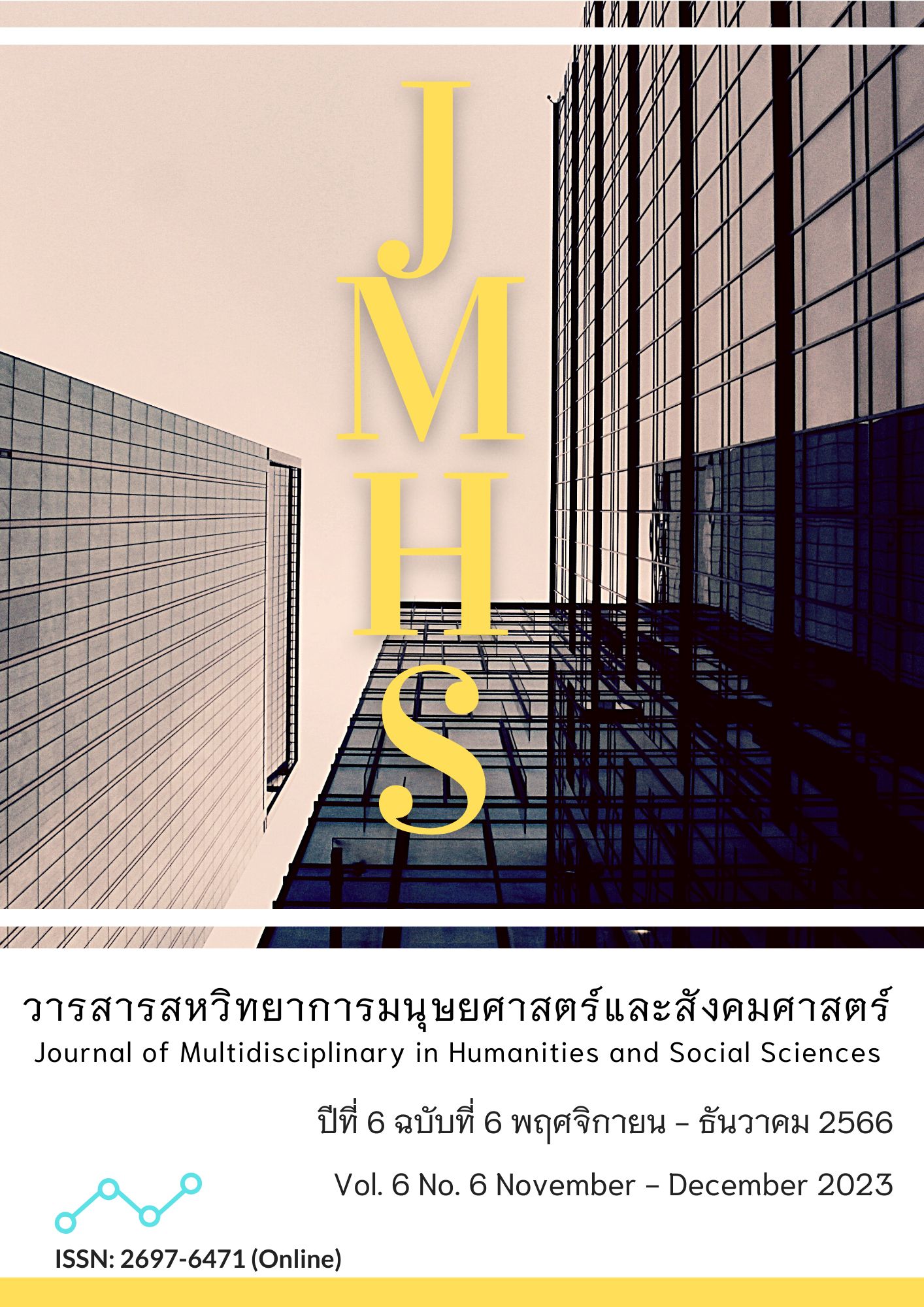Applied Behavioral Analysis to Reduce Self – Head Banging Behavior of a Child with Deafness and at Risk of Intellectual Disabilities
Main Article Content
Abstract
This research aimed to reduce the self-head banging behavior of deaf and at-risk children with intellectual disabilities by employing applied behavior analysis to create new alternative communication. The case study was obtained by purposive sampling. An 8-year-old boy was diagnosed with deafness by a physician and screened by trained teachers and occupational therapists with an educational screening form. Research tools were: 1) an alternative communication assessment set for a child with deafness and at risk of intellectual disabilities; 2) three individual lesson plans that were composed of 15 activities and took 30 minutes; and 3) a record observation of self-head banging. The data were analyzed by frequency, percentage, mean, and descriptive analysis.
The results showed that using an applied behavior analysis approach could reduce the self-head banging behavior of a child with deafness and at risk of intellectual disabilities, as follows: Baseline was 3, the first treatment session mean was 2.20, the withdrawal session mean was 0.60, and the second treatment session mean was 0.40, which could be interpreted as indicating that the numbers by head banging behavior decreased. The case study could use alternative communication in body language, picture cards, and sign language mode.
Knowledge of this research Reflecting on applied behavior analysis as a method of analyzing real objectives based on needs and finding ways to help, the case study chooses the method of assistance. Make the case study develop according to its ability to reach its fullest potential.
Article Details

This work is licensed under a Creative Commons Attribution-NonCommercial-NoDerivatives 4.0 International License.
Views and opinions appearing in the Journal it is the responsibility of the author of the article, and does not constitute the view and responsibility of the editorial team.
References
จริยา บุตรทอง. (2563). การพัฒนาทักษะการสื่อสารโดยใช้วิธีการสอนเพ็คส์ (PECS) ร่วมกับหลักการสอนแบบ 3R’s สำหรับเด็กออทิสติก ศูนย์การศึกษาพิเศษมหาจักรีสิรินธร ประจำจังหวัดนครนายก(วิทยานิพนธ์ปริญญาศึกษาศาสตรมหาบัณฑิต). มหาวิทยาลัยเทคโนโลยีราชมงคลธัญบุรี.
นิพัทธา หรรนภา. (2565). สภาพแวดล้อมและกิจกรรมการเรียนรู้สำหรับเด็กปฐมวัย. วารสารมนุษย์กับสังคม คณะมนุษย์ศาสตร์และสังคมศาสตร์, 7(2), 57-72.
ผดุง อารยะวิญญู. (2546). การศึกษาสำหรับเด็กที่มีความต้องการพิเศษ. (พิมพ์ครั้งที่ 2). กรุงเทพฯ: โรงพิมพ์ P.A.ART & PRINTING.
ปรียาพร วงศ์อนุตรโรจน์. (2551). จิตวิทยาการศึกษา. กรุงเทพฯ: พิมพ์ดี.
ประทีป จินงี่. (2558). การพัฒนาการเรียนรู้ของนิสิตด้วยการจัดการเรียนการสอนบนฐานทฤษฎีปัญญาสังคมผ่านสื่อวีดิทัศน์ขององค์การกระจายเสียงและแพร่ภาพสาธารณะแห่งประเทศไทย (Thai PBS). กรุงเทพฯ: สถาบันวิจัยพฤติกรรมศาสตร์ มหาวิทยาลัยศรีนครินทรวิโรฒ.
ยุวดี วิริยางกรู, ภทรา นาพนัง, และ วนิดา สินเบญจพงศ์. (2561). การจัดการพฤติกรรมสำหรับครูการศึกษาพิเศษ. เชียงใหม่: ลีโอมีเดียไซน์.
วิชิต เทพประสิทธิ์. (2559). กายศาสตร์กับการจัดสภาพแวดล้อมการเรียนรู้ในห้องคอมพิวเตอร์. วารสารมหาวิทยาลัยนราธิวาสราชนครินทร์, 7(2), 229-230.
สมโภชน์ เอี่ยมสุภาษิต. (2562). ทฤษฎีและเทคนิคการปรับพฤติกรรม. (พิมพ์ครั้งที่ 9). กรุงเทพฯ: จุฬาลงกรณ์มหาวิทยาลัย.
อรพันธุ ประสิทธิรัตน. (2564). การศึกษาสภาพแวดล้อมทางการเรียนของนิสิตคณะศึกษาศาสตร์มหาวิทยาลัยศรีนครินทรวิโรฒ. กรุงเทพฯ: มหาวิทยาลัยศรีนครินทรวิโรฒ.
อัชรา เอิบสุขสิริ. (2557). จิตวิทยาสำหรับครู. (พิมพ์ครั้งที่ 2). กรุงเทพฯ: จุฬาลงกรณ์มหาวิทยาลัย.
Alberto, P. A., & Troutman, A. C. (2012). Applied Behavior Analysis for Teachers. (9th ed.). New York: Pearson.
Ardoin, S.P., Wagner, L., & Bangs, K.E. (2016). Applied Behavior Analysis: A Foundation for Response to Intervention. In S.R. Jimerson, M.K. Burns, & A.M. Van Derheyden (Eds.), Handbook of Response to Intervention: The science and practice of multi-tiered systems of support (2nd ed., pp. 29–42). New York: Springer.
Bruce, S. M., & Borders, C. (2015). Communication and Language in Learners Who Are Deaf and Hard of Hearing with Disabilities: Theories, Research, and Practice. American Annals of the Deaf, 160(4), 368–384. http://www.jstor.org/stable/26235228
Cardinal, J. R. (2012). Retting Autism” Effectiveness of Web-Based Applied Behavior Video Modeling Program on the Performance of Paraeducators and Students with Autism Spectrum Disorder(Doctor of Philosophy, Department of Educational Psychology). The University of Utah. Retrieved from https://www.proquest.com/docview/1008914983/
Knowles-Cervantes, M. F. (2019). The Effects of Non-Contingent Reinforcement and Differential Reinforcement of Alternative Behaviors on the Reduction of Problem Behaviors and Acquisition of Alternative Responses for Children with Autism Spectrum Disorder(Doctor of Philosophy in Behavior Analysis). The Chicago School of Professional Psychology.
Lovaas, L. (2017). The Lovaas Center. Retrieved from http://thelovaascenter.com/about-us/dr-ivar-lovaas/
Rudy, L.J. (2023). What Is Applied Behavioral Analysis (ABA) Therapy for Autism?. Retrieved from https://www.verywellhealth.com/aba-applied-behavioral-analysis-therapy-autism-259913.
Tan, A. (2021.) Effectiveness of Applied Behavioral Analysis for Toddlers with Autism: A Scoping Review(Master of Health Care). Metropolia University of Applied Sciences. Retrieved from
https://www.theseus.fi/bitstream/10024/501452/2/Tan_Alexis.pdf
Tremblay, R. E., Gervais, J., & Petitclerc, A. (2012). Early Learning Prevents Youth Violence. Retrieved from https://www.child-encyclopedia.com/sites/default/files/tremblay_aggressionreport_ang.pdf


